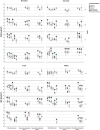Impact of Glazing, Coating, and Polishing on the Color Stability and Surface Properties of a 3D Printed Resin and Two Veneering Composite Resins
- PMID: 40102662
- PMCID: PMC12159786
- DOI: 10.1111/jerd.13462
Impact of Glazing, Coating, and Polishing on the Color Stability and Surface Properties of a 3D Printed Resin and Two Veneering Composite Resins
Abstract
Objective: To analyze the impact of various surface treatments on color stability and surface properties of a 3D printed and two veneering composite resins.
Materials and methods: Specimens were manufactured from a 3D printed (VarseoSmile CrownPlus) or two veneering composite resins (GRADIA PLUS; VITA VM LC flow) and underwent varnishing (OPTIGLAZE; VITA AKZENT LC), coating, polishing (goat hair brush; silicone polisher) or remained untreated. For 14 days, specimens were stored in red wine, curcuma, cress, or water. Individual and, for ΔE 00 > 1.8, professional prophylaxis was performed. Color (ΔE 00), surface free energy (SFE), and surface roughness (SR) were measured longitudinally. Mann-Whitney U, Kruskal-Wallis, Friedman, and Wilcoxon tests were computed (α = 0.05).
Results: For the 3D printed resin, varnishing, coating, or goat hair brushing minimized discoloration, while untreated surfaces showed the highest discoloration. Veneering composite resins benefited from goat hair brushing. Individual and professional prophylaxis improved surface properties and partially reversed discolorations. Solely goat hair brushed veneering composite resins achieved surface roughness values ≤ 0.2 μm.
Conclusions: To prevent discoloration, varnishing and goat hair brushing can be recommended for all materials. Individual prophylaxis was most effective for veneering composite resin 1, whereas professional prophylaxis significantly reduced discoloration on 3D printed resin. Only veneering composite resins treated with goat hair brushing achieved surface roughness values of ≤ 0.2 μm.
Clinical significance: As 3D printed resins tend to discolor easily, it is important to understand how different surface treatments may impact their color stability. Applying treatments such as varnishing, coating, and polishing can improve the color stability and surface properties, ensuring better esthetic results over time.
Keywords: CIEDE2000; additive manufacturing; color; glazing; optical properties; polishing.
© 2025 The Author(s). Journal of Esthetic and Restorative Dentistry published by Wiley Periodicals LLC.
Conflict of interest statement
The authors declare no conflicts of interest.
Figures



 ).
).

 SFE increases compared to T0;
SFE increases compared to T0;  SFE decreases compared to T0.
SFE decreases compared to T0.
 SFE increases compared to T0;
SFE increases compared to T0;  SFE decreases compared to T0.
SFE decreases compared to T0.Similar articles
-
Impact of varnishing, coating, and polishing on the chemical and mechanical properties of a 3D printed resin and two veneering composite resins.J Prosthet Dent. 2024 Aug;132(2):466.e1-466.e9. doi: 10.1016/j.prosdent.2024.05.006. Epub 2024 May 25. J Prosthet Dent. 2024. PMID: 38797579
-
The impact of in vitro aging on the mechanical and optical properties of indirect veneering composite resins.J Prosthet Dent. 2011 Dec;106(6):386-98. doi: 10.1016/S0022-3913(11)60153-4. J Prosthet Dent. 2011. PMID: 22133396
-
Influence of polishing technique and coffee thermal cycling on the surface roughness and color stability of additively and subtractively manufactured resins used for definitive restorations.J Prosthodont. 2024 Jun;33(5):467-474. doi: 10.1111/jopr.13730. Epub 2023 Jul 18. J Prosthodont. 2024. PMID: 37421940
-
Impact of thermocycling on mechanical properties and discoloration of veneering composite resins after storage in various staining media.J Prosthet Dent. 2021 Jun;125(6):940-945. doi: 10.1016/j.prosdent.2020.03.030. Epub 2020 Jul 2. J Prosthet Dent. 2021. PMID: 32624221
-
Evaluation of mechanical properties and color stability of 3D-printed denture base materials following two surface treatments.BMC Oral Health. 2025 Apr 30;25(1):671. doi: 10.1186/s12903-025-06056-5. BMC Oral Health. 2025. PMID: 40307743 Free PMC article.
Cited by
-
Roughness and Gloss of 3D-Printed Crowns Following Polishing or Varnish Application.Materials (Basel). 2025 Jul 14;18(14):3308. doi: 10.3390/ma18143308. Materials (Basel). 2025. PMID: 40731517 Free PMC article.
References
-
- Anadioti E., Kane B., and Soulas E., “Current and Emerging Applications of 3D Printing in Restorative Dentistry,” Current Oral Health Reports 5, no. 2 (2018): 133–139.
-
- Takada D., Kumagai T., Fusejima F., Ueno T., and Kariya S., “Wear Resistance Comparison of 3D‐Printed Composite Resin Material,” Dental Materials 38 (2022): e42.
-
- Erdemir U., Yıldız E., and Eren M. M., “Effects of Sports Drinks on Color Stability of Nanofilled and Microhybrid Composites After Long‐Term Immersion,” Journal of Dentistry 40 (2012): e55–e63. - PubMed
-
- Falkensammer F., Arnetzl G. V., Wildburger A., and Freudenthaler J., “Color Stability of Different Composite Resin Materials,” Journal of Prosthetic Dentistry 109, no. 6 (2013): 378–383. - PubMed
-
- Eltahlah D., Lynch C. D., Chadwick B. L., Blum I. R., and Wilson N. H. F., “An Update on the Reasons for Placement and Replacement of Direct Restorations,” Journal of Dentistry 72 (2018): 1–7. - PubMed
MeSH terms
Substances
LinkOut - more resources
Full Text Sources
Research Materials

